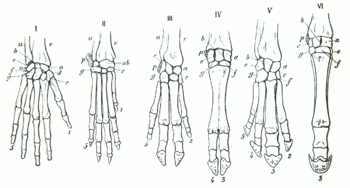Karl Gegenbaur facts for kids
Quick facts for kids
Karl Gegenbaur
|
|
|---|---|
| Born | 21 August 1826 |
| Died | 14 June 1903 (aged 76) |
| Nationality | German |
| Known for | use of homology in theory of evolution |
| Awards | Copley Medal (1896) |
| Scientific career | |
| Fields | Comparative anatomy |
| Institutions | University of Heidelberg, University of Jena |
Karl Gegenbaur (born August 21, 1826 – died June 14, 1903) was an important German scientist. He was a professor who studied anatomy, which is the study of the body's structure. Gegenbaur showed that comparing the bodies of different animals (called comparative anatomy) gives strong proof for the idea of evolution. He taught at the University of Jena and the University of Heidelberg. He was a big supporter of Charles Darwin's theory of evolution. He also worked closely with another famous scientist, Ernst Haeckel.
Gegenbaur wrote a very important book called Grundzüge der vergleichenden Anatomie in 1859. This book became a standard textbook for studying how animals' bodies are built and how they evolved. He showed that if different animals have similar body parts, it can tell us about their shared evolutionary past.
Karl Gegenbaur believed that the best way to understand evolutionary history is through homology. This means comparing body parts that have a common origin, even if they look different now. For example, a human arm, a bat's wing, and a whale's flipper are homologous because they all developed from the same basic structure in an ancient ancestor.
Contents
Karl Gegenbaur: A Pioneer in Anatomy
His Life Journey
Karl Gegenbaur was born in Würzburg, Bavaria, in 1826. He started studying at the University of Würzburg in 1845. After finishing his degree in 1851, he traveled around Italy and Sicily.
In 1854, he returned to Würzburg. A year later, in 1855, he became a professor of anatomy at the University of Jena. By 1858, he was a full professor there. Later, in 1865, his former student, Ernst Haeckel, became a professor of zoology at the same university.
In 1873, Gegenbaur moved to Heidelberg. He became a professor of anatomy and led the Anatomical Institute until he retired in 1901. He was recognized for his work and became an honorary member of the American Academy of Arts and Sciences in 1896. He passed away in Heidelberg on June 14, 1903.
What He Discovered

Gegenbaur's most famous work is his book Grundriss der vergleichenden Anatomie (1874). This book was translated into English as Elements of Comparative Anatomy. He believed that comparing the anatomy of different animals was very important for understanding how they are related. He focused on homologies, which are the relationships between similar parts in different animals. For example, he compared a human arm to a horse's front leg or a bird's wing.
Gegenbaur also helped to disprove an old idea about the skull. Some scientists thought the skull was made from changed vertebrae (the bones that make up your spine). Gegenbaur showed that in simple fish, the skull is a single, unsegmented box made of cartilage. He proved that the skull is not just a modified part of the spine.
In 1858, Ernst Haeckel, who later became a famous scientist, studied under Gegenbaur at Jena. Haeckel built on Gegenbaur's ideas and became a strong supporter of Charles Darwin's theories.
In 1861, Gegenbaur published an important paper about how eggs develop in animals with backbones. He showed that the egg cell is a single cell in all these animals. This was a key discovery in the study of embryology, which is the study of how living things develop before birth.
His Influence on Science
Gegenbaur learned many techniques from his own teachers, including Albert von Kölliker and Rudolf Virchow. He also had a big impact on his colleagues, like Matthias Jakob Schleiden and Ernst Haeckel.
Many students were also influenced by Gegenbaur's teaching. Some of his notable students included Max Fürbringer, Richard Hertwig, and Oskar Hertwig.
Gegenbaur's way of studying comparative anatomy, which looked at both how animals develop (ontogeny) and their evolutionary history (phylogeny), is still important today. It can be seen in a modern field of science called evolutionary developmental biology, or "evo-devo."
Other Works
Karl Gegenbaur also wrote a Text-book of Human Anatomy (1883). He published works on specific body parts, like the Epiglottis (1892). He also wrote a book comparing the anatomy of animals with backbones to those without (1898–1901). In 1875, he started a scientific journal called Morphologisches Jahrbuch (Morphological Yearbook), which he edited for many years. In 1901, he wrote a short book about his life and experiences called Erlebtes und Erstrebtes.
See also
 In Spanish: Carl Gegenbaur para niños
In Spanish: Carl Gegenbaur para niños

